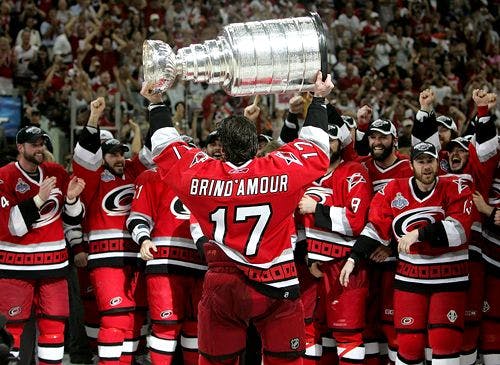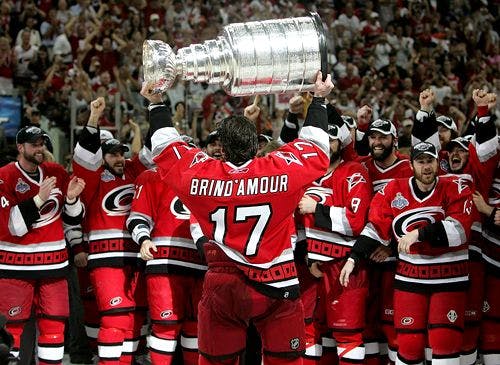A New Way To Predict Team Success


1) It only gives you winning percentage, which does not factor in overtime and shootout losses.
2) There are measurable factors that compose goals for and against that we can analyze
I decided to do a regression analysis to discover what is hopefully a better formula. I decided to use the data for every post-lockout team season, giving me 120 data points to work with. My first regression lined up points against PP%, PK%, 5 on 5 goals for and against, goals against per game, goals scored per game, shots per game and shots against per game. I was quickly able to eliminate the two shot categories thanks to their high P-values, leaving me with a formula with a r-squared of .843. Not too shabby. I was happy enough with this and decided to move forward. My formula is 22.771 + 0.714PP% + 0.480PK% + 23.960fiveon five + 16.703 GPG -19.541 GAPG.
My next step was to apply this formula to every team following the lockout. Now that I had this information, I had to think of something interesting to do with it. I thought the most useful thing to do would be to calculate the difference between each team’s expected point total and their actual performance. This will help find out who has been lucky and unlucky over the last four seasons.
The Lucky Ones
1) 2005-06 Carolina Hurricanes
Despite an expected point total of only 95, this team was tied for the 3rd best record in the NHL with 112 points, and was the number two seed in the Eastern Conference. This made their path to the Stanley Cup Finals much easier, and they went on to defeat the Edmonton Oilers in seven games to capture their first championship.
2) 2006-07 New Jersey Devils
This team boosted themselves from a predicted 93.5 points (and 7th seed) to the second overall spot in the East with 107 points. They were even outscored by their opponents during five on five play throughout the regular season, and undeserving of this high seed. The promptly lost to a 4th seeded, but vastly superior Ottawa Senators team in the 2nd round.
3) 2005-06 Los Angeles Kings
Usually overperforming is a good thing as it allows the team to get a more favourable seeding position in the playoffs. However, this is not always the case. The Kings bumped themselves up from 79 to 89 points but still finished outside the playoff picture as the 9th seed in the West. Their expected finish would have given them the 8th overall pick in the 2006 Entry Draft and the right to draft Peter Mueller, Michael Frolik, Jonathan Bernier or Bryan Little instead of… Trevor Lewis.
4) 2005-06 Philadelphia Flyers
The Flyers moved themselves into the playoff picture with an increase from 92 to 101 points, and were seeded number five in the East. They showed their true colours and were eliminated in the first round in six games by the Buffalo Sabres
5) 2006-07 Anaheim Ducks
In a crazy year during which 104 points only got the Minnesota Wild a seven seed in the West, the Ducks outperformed their 101 expected points and finished second to Detroit with 110 points. This was still an excellent hockey team, and they went on to win the Stanley Cup, losing only five games along the way.
Two out of the five luckiest teams went on to win the Stanley Cup, so maybe I should not put too much weight into these rankings. It is also possible that the playoffs are just a crapshoot, and the sample sizes are not large enough to make any serious predictions.
The Unlucky Ones
1) 2005-06 Ottawa Senators
Unbelievably, the most unlikely team on this list also finished as a number one seed. This team was predicted to accumulate a whopping 129 points, but finished with 113. Their expected total was so high thanks to excellent special teams and a 1.49 five on five GF/GA ratio. This performance did not carry over in to the post-season, where Ottawa collapsed in typical Senators fashion in the second round, bowing out in five games to the Buffalo Sabres.
2) 2006-07 Philadelphia Flyers
Even had the performed up their expected level of 71 points, this squad would have still been one of the five worst teams in the NHL. That tends to happen when you are the only team in the league to allow more than 300 goals. Instead, they finished in dead last and drafted James Van Riemsdyk second overall, a young man who promises to be an excellent NHL player. Unfortunately for them, they had the greatest chance of landing the first overall pick and drafting future NHL 10 cover boy Patrick Kane.
3) 2006-07 Phoenix Coyotes
Like most of the teams on this part of the list, the Coyotes were a bad team who performed even worse than expected. A drop to 67 points from an expected total of 80 earned them the right to draft BCHL standout Kyle Turris, who has yet to pan out at the NHL level but still has incredible promise.
4) 2005-06 Pittsburgh Penguins
Despite boasting rookie Sidney Crosby, this was still a terrible hockey team. They finished second to last in the NHL with 58 points, down from an expected total of 70. This allowed them to draft a key component of their Stanley Cup championship team at second overall, Jordan Staal, although they would have been just fine with the three guys drafted after him, Jonathan Toews, Nicklas Backstrom and Phil Kessel.
5) 2005-06 Minnesota Wild
This one really hurt. Had the Wild outperformed their expectations by only a single point, they would have finished with 95 points, good for a three way tie for the final two playoff spots with Colorado and Edmonton. Instead, they finished with 84 points, well out of the playoff picture.
Overall, this bottom portion of the list is littered with bad teams who performed even worse than their predictions, possibly in an attempt to snag a better draft pick. Not that I would ever accuse NHL teams of tanking down the stretch!
Conclusion
When comparing to the Pythagorean Expectation, I believe my formula is superior because it measures total points, not just wins, and takes into account more factors than simply goals for and against. However, for the casual fan, the Pythagorean method is better because it is much simpler are requires no outside knowledge of regression or Excel.
As a final note, I made one very interesting discovery. Normally, we would expect to see an even distribution of teams from each year throughout the rankings. However, the 2007-08 and 2008-09 seasons were clumped much closer to the middle. All the teams I covered in my article were from the 2005-06 and 2006-07 seasons, and eight of the nine luckiest teams as well as ten of the twelve unluckiest teams were from the same time period. I do not know if this is just the luck of the draw or if there is something deeper at play. But that is a story for another day.